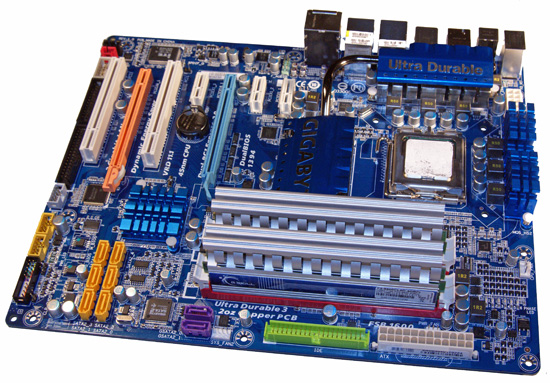Gigabyte GA-EP45-UD3P - P45 at its Finest
by Gary Key on February 3, 2009 12:15 AM EST- Posted in
- Motherboards
It seems like ages ago when Intel released the P45 Express chipset. In fact it was just last June, but that is normally an eternity in the personal computer market. After our first look at the chipset, we were not convinced that it could be successful. The P35 Express chipset was mature, less expensive, and a very popular choice for the first time buyer and enthusiast alike. Anyone needing high-end performance for a CrossFire setup had numerous options to choose from with the X38/X48 based motherboards. What seemed like the final nail in the coffin is that board pricing was closer to X38 territory than the P35 and initial performance numbers just did not wow anyone.
Beyond that, it seemed like the upcoming Nehalem platform was getting more press than the P45. Most of us were wondering out loud why anyone would invest in a brand new chipset based on a previous generation processor when the mother of all platforms was getting ready to launch. Not to mention, except for CrossFire capabilities upgraded from x16/x4 on the P35 to a performance friendly x8/x8 setup, what did the P45 really offer?
As it turns out, this chipset had a lot to offer. Of course, the stars seemed to align perfectly for its march to success. After a few rough patches with early BIOS releases, this chipset became the favorite upgrade choice for the enthusiast due to its incredible front-side bus and memory overclocking capabilities. AMD released two of the best value/performance video cards in recent memory with the HD 4870 / HD 4850 video cards and all of a sudden you could run CrossFire on a mainstream board without spending a fortune. Intel pushed this chipset heavily and the motherboard manufacturers started pumping out various models from the low-end $80 market up to the high-end $250 sector. The P45 was everywhere and available at almost any price point - we last counted about 100 different models available from just about every manufacturer in the business.

It’s hard not to get lost in the sea of available models when searching the web sites at ASUS, MSI, Gigabyte, and others. Thanks to aggressive price cuts on the Core 2 series of processors and with the Core i7 platform regulated to the high-end market until the end of this year, the opportunity for the P45’s star to shine brightly continues for the immediate future. Based on recent information from Intel we can expect to see the P45 around until 2011.
One of the industry's leading supporters of the P45 chipset is Gigabyte. At last count, Gigabyte had fifteen P45 motherboards in their lineup. Gigabyte has already released six new P45 second-generation products based on their Ultra Durable 3 technology. We will be taking an in-depth look at the Ultra Durable 3 technology in separate article shortly. In the meantime, today we are reviewing one of the top models in the Ultra Durable 3 lineup, the GA-EP45-UD3P.
This particular board offers CrossFire support in dual x8 mode, native support for DDR2-1366 memory speeds, a revised cooling system, dual PCI-E Gigabit LAN controllers with teaming, and Dolby Home Theater support via the Realtek ALC889a. Add in an integrated TPM data encryption chip, eight SATA ports, Dynamic Energy Saver power management system, and IEEE 1394a support plus several other features and you just bought the kitchen sink with this board. Speaking of buying, the current retail pricing is around $135 and a $20 rebate is available, meaning there is a lot of value packed into this blue wonder board.
Did the Gigabyte GA-EP45-UD3P impress us? Let’s find out now.










73 Comments
View All Comments
poohbear - Tuesday, February 3, 2009 - link
thanks for benching @ 1680x1050 so we know real world usage. hate it when they bench @ a real low rez even if there's a difference as that means nothing to 99% of ppl that game @ anything but the lower resolutions.:)crimson117 - Tuesday, February 3, 2009 - link
When they bench at low resolutions, it's to discover any CPU bottleneck. It's the equivalent of saying, "we know the GPU can handle this low res at super high framerates, so will the CPU processing the game mechanics keep the framerates down?".For example, an RTS like Supreme Commander will have okay graphics, but most of the horsepower will be the CPU calculating troop movement, damage, etc, especially on large maps with lots of players. So they'll want to take the GPU's rendering speed out of the equation and see how fast the CPU can do its gameplay calculations.
This can really help people know which part of their computer to upgrade. A friend of mine has an E6300 Conroe 1.86GHz (one of the earliest C2D's), so his CPU is pretty old. He has a 9800GT graphics card. If he wants to play Supreme Commander with 10 opponents at once, should he upgrade his graphics or his CPU?
At low resolutions, the video card can handle it no problem, but no matter what resolution, the CPU still has to calculate 10 players actions at once. If they only benchmarked at high resolution, then the graphics lag would mask the fact that the CPU calculations were also laggy. So by reducing the resolution to really low levels, he'd find out the CPU still can't keep up and should be upgraded.
zebrax2 - Tuesday, February 3, 2009 - link
seems like those polls are starting to take effect